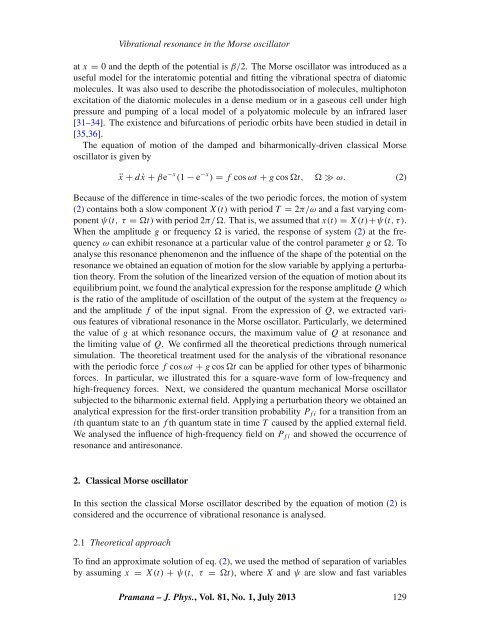Vibrational resonance in the Morse oscillator - Indian Academy of ...
Vibrational resonance in the Morse oscillator - Indian Academy of ...
Vibrational resonance in the Morse oscillator - Indian Academy of ...
You also want an ePaper? Increase the reach of your titles
YUMPU automatically turns print PDFs into web optimized ePapers that Google loves.
<strong>Vibrational</strong> <strong>resonance</strong> <strong>in</strong> <strong>the</strong> <strong>Morse</strong> <strong>oscillator</strong><br />
at x = 0 and <strong>the</strong> depth <strong>of</strong> <strong>the</strong> potential is β/2. The <strong>Morse</strong> <strong>oscillator</strong> was <strong>in</strong>troduced as a<br />
useful model for <strong>the</strong> <strong>in</strong>teratomic potential and fitt<strong>in</strong>g <strong>the</strong> vibrational spectra <strong>of</strong> diatomic<br />
molecules. It was also used to describe <strong>the</strong> photodissociation <strong>of</strong> molecules, multiphoton<br />
excitation <strong>of</strong> <strong>the</strong> diatomic molecules <strong>in</strong> a dense medium or <strong>in</strong> a gaseous cell under high<br />
pressure and pump<strong>in</strong>g <strong>of</strong> a local model <strong>of</strong> a polyatomic molecule by an <strong>in</strong>frared laser<br />
[31–34]. The existence and bifurcations <strong>of</strong> periodic orbits have been studied <strong>in</strong> detail <strong>in</strong><br />
[35,36].<br />
The equation <strong>of</strong> motion <strong>of</strong> <strong>the</strong> damped and biharmonically-driven classical <strong>Morse</strong><br />
<strong>oscillator</strong> is given by<br />
ẍ + dẋ + βe −x (1 − e −x ) = f cos ωt + g cos t, ≫ ω. (2)<br />
Because <strong>of</strong> <strong>the</strong> difference <strong>in</strong> time-scales <strong>of</strong> <strong>the</strong> two periodic forces, <strong>the</strong> motion <strong>of</strong> system<br />
(2) conta<strong>in</strong>s both a slow component X (t) with period T = 2π/ω and a fast vary<strong>in</strong>g component<br />
ψ(t, τ= t) with period 2π/. That is, we assumed that x(t) = X (t)+ψ(t,τ).<br />
When <strong>the</strong> amplitude g or frequency is varied, <strong>the</strong> response <strong>of</strong> system (2) at <strong>the</strong> frequency<br />
ω can exhibit <strong>resonance</strong> at a particular value <strong>of</strong> <strong>the</strong> control parameter g or . To<br />
analyse this <strong>resonance</strong> phenomenon and <strong>the</strong> <strong>in</strong>fluence <strong>of</strong> <strong>the</strong> shape <strong>of</strong> <strong>the</strong> potential on <strong>the</strong><br />
<strong>resonance</strong> we obta<strong>in</strong>ed an equation <strong>of</strong> motion for <strong>the</strong> slow variable by apply<strong>in</strong>g a perturbation<br />
<strong>the</strong>ory. From <strong>the</strong> solution <strong>of</strong> <strong>the</strong> l<strong>in</strong>earized version <strong>of</strong> <strong>the</strong> equation <strong>of</strong> motion about its<br />
equilibrium po<strong>in</strong>t, we found <strong>the</strong> analytical expression for <strong>the</strong> response amplitude Q which<br />
is <strong>the</strong> ratio <strong>of</strong> <strong>the</strong> amplitude <strong>of</strong> oscillation <strong>of</strong> <strong>the</strong> output <strong>of</strong> <strong>the</strong> system at <strong>the</strong> frequency ω<br />
and <strong>the</strong> amplitude f <strong>of</strong> <strong>the</strong> <strong>in</strong>put signal. From <strong>the</strong> expression <strong>of</strong> Q, we extracted various<br />
features <strong>of</strong> vibrational <strong>resonance</strong> <strong>in</strong> <strong>the</strong> <strong>Morse</strong> <strong>oscillator</strong>. Particularly, we determ<strong>in</strong>ed<br />
<strong>the</strong> value <strong>of</strong> g at which <strong>resonance</strong> occurs, <strong>the</strong> maximum value <strong>of</strong> Q at <strong>resonance</strong> and<br />
<strong>the</strong> limit<strong>in</strong>g value <strong>of</strong> Q. We confirmed all <strong>the</strong> <strong>the</strong>oretical predictions through numerical<br />
simulation. The <strong>the</strong>oretical treatment used for <strong>the</strong> analysis <strong>of</strong> <strong>the</strong> vibrational <strong>resonance</strong><br />
with <strong>the</strong> periodic force f cos ωt + g cos t can be applied for o<strong>the</strong>r types <strong>of</strong> biharmonic<br />
forces. In particular, we illustrated this for a square-wave form <strong>of</strong> low-frequency and<br />
high-frequency forces. Next, we considered <strong>the</strong> quantum mechanical <strong>Morse</strong> <strong>oscillator</strong><br />
subjected to <strong>the</strong> biharmonic external field. Apply<strong>in</strong>g a perturbation <strong>the</strong>ory we obta<strong>in</strong>ed an<br />
analytical expression for <strong>the</strong> first-order transition probability P fi for a transition from an<br />
ith quantum state to an f th quantum state <strong>in</strong> time T caused by <strong>the</strong> applied external field.<br />
We analysed <strong>the</strong> <strong>in</strong>fluence <strong>of</strong> high-frequency field on P fi and showed <strong>the</strong> occurrence <strong>of</strong><br />
<strong>resonance</strong> and anti<strong>resonance</strong>.<br />
2. Classical <strong>Morse</strong> <strong>oscillator</strong><br />
In this section <strong>the</strong> classical <strong>Morse</strong> <strong>oscillator</strong> described by <strong>the</strong> equation <strong>of</strong> motion (2) is<br />
considered and <strong>the</strong> occurrence <strong>of</strong> vibrational <strong>resonance</strong> is analysed.<br />
2.1 Theoretical approach<br />
To f<strong>in</strong>d an approximate solution <strong>of</strong> eq. (2), we used <strong>the</strong> method <strong>of</strong> separation <strong>of</strong> variables<br />
by assum<strong>in</strong>g x = X (t) + ψ(t, τ = t), where X and ψ are slow and fast variables<br />
Pramana – J. Phys., Vol. 81, No. 1, July 2013 129
















